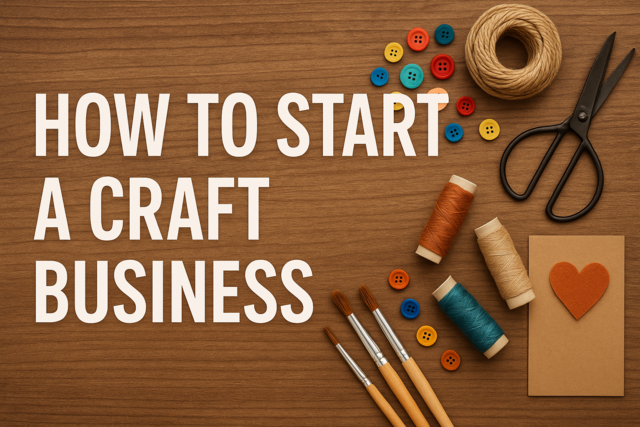Selling On The Computer
Today, home-based businesses have an advantage that no other generation of crafters had before: the Internet. The Internet offers limitless options for selling your hand crafts. You can sell your crafts on eBay, or sites like Amazon, etsy.com, and/or develop your own website and sell from there; you can contact regional, national, and international craft vendors, and more.
Online selling sites like Etsy, eBay, Amazon, and such are typically the same in regard to format:
- Create an account
- List your craft items
- Sell to a buyer
- Get paid
- Ship to customers
In addition, online stores hosted by such sites generally offer some site design, which may include banners, shopping and shipping policy information, ample space for uploading photos of your crafts, and your profile. Etsy.com even offers more potential to reach customers through Alchemy, which offers a point of contact between crafters and potential buyers that enables crafters or sellers to bid on purchasing orders and products listed there.
We will explore the benefits of developing a website for your craft business a little later, but for now, access as many avenues through the Internet as you can. You can focus on selling to distributors, clubs, or crafting businesses that are larger and already developed, or you can create your own supply and demand chain with a bit of effort and dedication.
Online business and auction sites, such as eBay, continue to be popular among crafters. They are relatively cheap, and can reach global purchasers. Whether you decide to sell your crafts on eBay, or another online auction or business site, you will more than likely need to create an account. You may also need to develop a login or screen name, and password.
Most online vendor sites, such as eBay, offer users some form of tutorial on how to set up pages that display your crafts, as well as enable you to communicate with potential buyers. Be aware that such websites will demand a listing fee for any item. Your listing fees can be as low as 25 cents, but may also go up, depending on the overall price of your items.
Selling Your Crafts At Craft Shows
One of the tried and true methods of selling your crafts, is to attend local and regional craft shows. Craft shows will help provide name recognition, as well as enable potential buyers to view a variety of your crafts in person. Craft shows are especially popular in rural areas prior to the holidays, offering prime opportunities to make profits.
Take the time to research the types of craft shows scheduled for your area, and make sure they will suit your type of craft. For example, many craft shows are general in nature, offering everything from Christmas gifts, to handmade jewelry, to bird houses, and iron work, just to name a few. Others focus only on Christmas items, while others may focus only on quilts and quilted crafts and so forth. Look in crafting magazines, or online crafting publications, for information regarding posted events for crafters in your area.
Renting a booth at a craft show costs money, and while these costs will depend on where you are located, keep in mind that the result from renting a booth, as an investment perspective, may only make you enough money to break even. However, getting your face and your crafts out there may be worth the effort and the expense. Regardless, you want to at least break even. Before you attend a craft show, make sure you have made enough of your craft item to offer a variety of options, sizes, and colors for potential customers.
Be prepared to vocally sell your craft as well as display it. Customers may be interested to know why you focus on certain crafts or aspects of your craft, and may want to know how you make it, how long it takes, and so forth. You may even consider working on one of your crafts at the show, so people can see you producing your craft while they browse.
When you attend a craft show, invite your potential customers to touch, feel and freely look at your crafts. This way, they will be able to determine the quality and durability of your craft. People like to touch and feel what they might be buying, so do not hesitate to offer them that opportunity.
Custom Orders And Consignments
While not the most traditional method of selling your crafts, more crafters today are looking into consignments. Selling your crafts on consignment means placing your crafts in gift shops or businesses in your local area prior to receiving payment. You will split the profits on your craft with the store owner. This method of selling crafts comes with its own set of pros and cons. While you will be able to enjoy a greater marketability for your crafts, you also have to share the profits of your hard work.
There are different types of consignments, such as sharing a percentage of the sales with the shop owner, or a percentage of your sales for the amount of space in the business where your products are displayed. Determine ahead of time whether or not consignment businesses in your area may offer you benefit and profits, and then get details in writing.
Craft Home Parties
In some areas, crafters get together once a month, or several times a year, to host home-based crafting parties. Much like traditional Avon or Tupperware parties of the past, this enables groups of interested individuals to come to your home to look at, and hopefully purchase, your crafts -- and maybe even learn how to make a few. However, you may need to determine the answers to a number of questions beforehand, not the least of which is, whether or not you will need a permit to sell your business items from your home, as well as whether you have enough space to not only display your crafts, but provide access to visitors interested in your craft.
Conclusion
As you can see, there are a wide number of options and opportunities to sell your crafts, and you will need to determine which ones work best for you. Before you decide to sell your crafts through any method listed in this article, make sure you have a good supply of crafts available to clients. Because crafted items may take anywhere from a day, to several weeks to create, it is best not to keep your customers waiting, in case you run out of items when you have underestimated interest or demand for your craft.
When creating an adequate supply of craft items for your potential customers, you will need to have adequate supplies on hand to do so.
Saving on Supplies
Introduction
A basic tenet of any business, and that includes a home-based craft business, is to keep your overhead down. Overhead is the term used to describe expenses incurred by a business. Such expenses may include supplies, utility bills, rental space, (which does not apply to a home-based business), and such things as insurance costs and equipment -- computers, fax machines, printers, and any machines or tools needed to create your crafts.
Basic Equipment
These days, a home-based business can operate with full functionality with a few basic, but very necessary, pieces of equipment. Such equipment may include a computer, printer, and fax machine. When communicating with clients and potential customers, you may need to use the telephone. Today, land lines are disappearing in favor of the VOIP Services. VOIP stands for Voice Over Internet Protocol. Examples of such services includes Skype, Vonage, and Google Voice.
While a land line still provides the best clarity, they are also one of the most expensive telephone services today, especially when contacting international customers. However, keep in mind that if you utilize Internet telephone services, you may experience down time during power outages.
In addition to Internet telephony, most people today use cell phones, and increasingly do business with their cell phones, as it offers easy accessibility. Most business owners carry their cell phones with them throughout the day, offering enhanced availability and access, as well as the capability of taking orders, or answering questions 24/7, if you are super-dedicated. Otherwise, create a voice mail stating your business operating hours, and tell potential customers that you will return their call in a certain amount of time.
If you prefer a traditional land line, look into the possibility of advertising in the Yellow Pages with only a residence land line. Compare telephone long distance rates to get the best deals.
Fax machines are not mandatory, but may be convenient for receiving and sending orders. Your computer ordering system is also an excellent way to receive product requests, and offers easy email, chat, and telephone access for a basic monthly cost.
Other Expenses
Buying Supplies When buying supplies for your home-based craft business, it is a good idea to buy wholesale. Wholesale generally means buying in bulk. Retail means paying the price offered at stores. For example, let's say you are offering knitted crafts. You can go to craft stores, such as Hobby Lobby or Michaels, but you are going to pay retail prices for your yarn. However, if you order wholesale, which means buying in bulk, you may spend more initially, though you are purchasing every skein or batch of yarn at a cheaper price.
Regardless of your craft, check with wholesale suppliers to determine the minimum order amounts for your supplies. This may save you hundreds, if not thousands, of dollars a year.
Locate a number of craft suppliers in your area and call them. Ask them whether or not they can sell you bulk supplies, even if you are not a physical store or craft supply dealer. In many cases, individuals can buy directly from manufacturers. Doing so can lower your supply costs by as much as 50 percent.
Create a list of the types of supplies you need to build your crafts. Break these down into costs that you pay when purchasing your supplies from your local craft or retail store. Then, look in the phone book, or online, for wholesale suppliers; determine whether or not they will sell in bulk to you, and then find out about shipping and handling charges. Always compare prices for both methods to determine which will save you the most money in the long run.
Packaging
When selling home-based crafts, you need to also think about packaging. Your packaging needs to be attractive, yet functional, and able to protect your craft when shipping. In some cases, you may need to have special envelopes and boxes, or have packaging custom-designed for your product. For example, you do not want to pack a bird house the same way you would pack a doll, a knitted sweater, or a Native American dream-catcher.
Keep in mind that the larger the package, the higher your shipping costs are going to be. You also need to protect your craft while in route, which may mean, and is not limited to, bubble wrap, foam pellets, or other special packaging.
Check at your local retail office supply stores to determine their basic costs for various-sized shipping containers, bubble wrap, or pellets. Then contact shipping and packaging wholesalers, and compare prices. Again, order adequate supplies in advance.
While you do not want to spend an excess amount of money on packaging, you do want to make the packaging appeal to your clients. Simply sticking a doll into a cardboard box and shipping it is not acceptable. You will need to somehow wrap and present that doll to your customer in an appropriate and attractive manner. This will generate good feedback and also show the customer that you take care and pride -- not only in creating your craft, but making sure that it reaches its destination safely, and in one piece.
Mail ordering your crafts may also require a little extra expense and time. Determine the cost of mailing by surface, air, or express, as well as the dimensions of your packages, so that you can anticipate mailing costs, which may be passed on to the buyer. In most cases, when selling online, you will state the price of the product in addition to shipping and handling charges, which will help cover your costs.
Be very specific when listing shipping and handling costs to different areas of the country. For example, if you live in Arizona, it is not going to cost the same to ship to New Mexico, as it does to Maine. Take the time to research various weights and sizes of packages to anticipate your costs, which will also help save you money, and keep your overhead costs down in the long run.
Conclusion
When you open your own home-based craft business, it is natural to focus only on the developing and completion of your crafts. As you can see so far, opening your own business requires a bit of time and effort in learning some of the ins and outs of a home-based business. While all of these things -- learning a little bit about targeting a market, determining your earning potential, and whether or not you should buy wholesale, determining mailing costs, and how to set up your business -- may take away from your crafting, they are essential to running a successful home-based craft business.

























